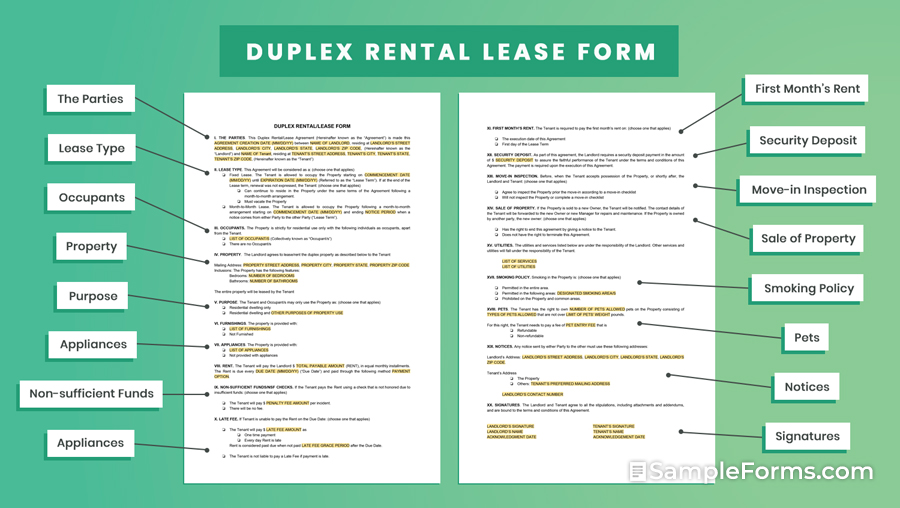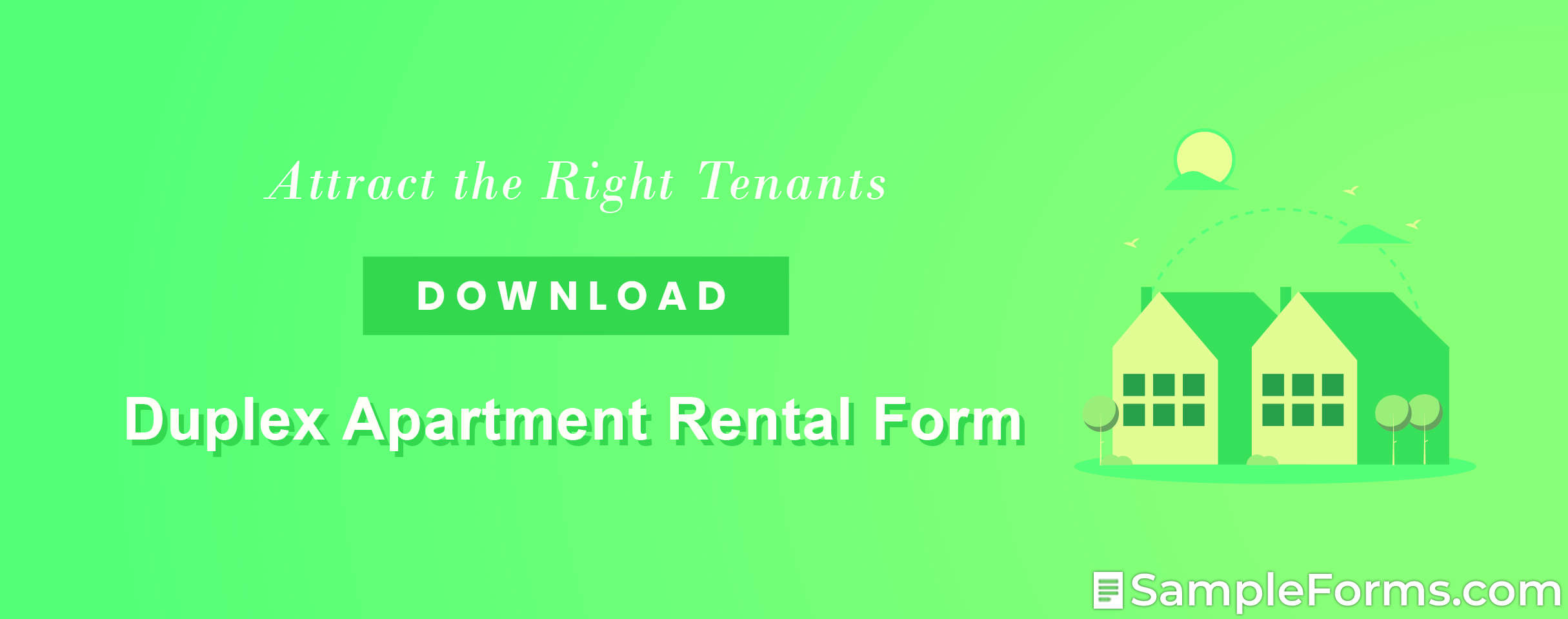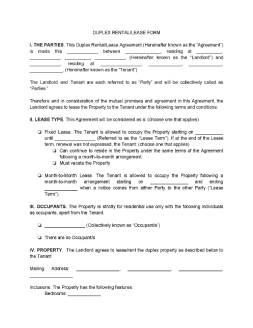- Eviction Notice Forms
- Power of Attorney Forms Forms
- Bill of Sale (Purchase Agreement) Forms
- Lease Agreement Forms
- Rental Application Forms
- Living Will Forms Forms
- Recommendation Letters Forms
- Resignation Letters Forms
- Release of Liability Agreement Forms
- Promissory Note Forms
- LLC Operating Agreement Forms
- Deed of Sale Forms
- Consent Form Forms
- Support Affidavit Forms
- Paternity Affidavit Forms
- Marital Affidavit Forms
- Financial Affidavit Forms
- Residential Affidavit Forms
- Affidavit of Identity Forms
- Affidavit of Title Forms
- Employment Affidavit Forms
- Affidavit of Loss Forms
- Gift Affidavit Forms
- Small Estate Affidavit Forms
- Service Affidavit Forms
- Heirship Affidavit Forms
- Survivorship Affidavit Forms
- Desistance Affidavit Forms
- Discrepancy Affidavit Forms
- Guardianship Affidavit Forms
- Undertaking Affidavit Forms
- General Affidavit Forms
- Affidavit of Death Forms
Duplex Apartment Rental Form
Leasing and renting are viable options for individuals who want to live in their preferred homes without emptying out their pockets. But, as this demand consistently increases over time, more people are also more attuned to learning how to use a rental or lease form. This article introduces the use, importance, and how-tos of creating a Duplex Rental Form. Read on to know more about this form, especially for those who are interested in renting duplexes. Read More
Duplex Apartment Rental Form
What Is a Duplex Rental/Lease Form?

Some prefer to live in smaller but refreshing spaces and aim for a minimalist lifestyle. On the other hand, a portion of the population still prefers to live in the traditional and comfortable space of duplexes. To do so, most opt to lease a duplex for a particular period. And one document that makes this transition happen is the duplex rental/lease form. It lays down all the terms and conditions between the landlord and the tenant. All these terms must be followed by both parties to avoid any type of conflict between the two. It also serves evidence to support a claim of either party.
How Do You Compose a Duplex Rental/Lease Form?
The media outlet, CNBC, reported a conclusion from a study by the Pew Research Center stating that as of 2016, 36.6% of the total population in the United States prefer to lease houses than to own them. Have you ever tried to rent your own room or house before? If you are thinking about renting or leasing a property soon, this list provides a concise step by step run-through of a typical duplex rental/lease form.
1. Start With the Basics
The first part of this lease or rental form asks for the basic details of the parties involved, the nature of the party, and the other occupants of the residence are there are any. Starting with the parties, it requires the legal names of the landlord and a representative of the occupants to bear the label of the tenant. Next, the nature of the lease is discussed. It can either be a fixed or month-to-month lease. The commencement and expiration dates are essential details that should be present. Lastly, the names of the other occupants, aside from the tenant above, must be stated. Failure to do so is enough reason for the landlord not to push through with the agreement.
2. Know the Property and its Condition
After these details, discuss the property. In this case, it’s a duplex. Then include the address of the property along with the description of some of its features, such as the number of bedrooms and bathrooms. Moreover, the form clearly states that the property is strictly for residential use only, unless the landlord allows it for any form of commercial use. Duplex rentals can also either be fully or semi-furnished. Thus, it also falls to the landlord’s responsibility to provide the information if the property comes with particular pieces of furniture and other fixtures.
3. Be Critical With the Payment Arrangement
A significant portion of the form, other than the subsequent terms and conditions, discusses the amenable payment arrangement between the parties. This portion of the form requires the details of the rental arrangement, late fees, non-sufficient funds, first month’s rent payment, and security deposit. It asks for the exact amounts for these conditions mentioned above, as well as how to transfer the payment to the landlord.
4. Discuss the Additional Terms and Conditions of the Lease
The additional terms and conditions of the lease make up the majority of the lease form. It mostly covers the responsibility of the landlord to the property, with its maintenance and upkeep, for the term. Also, the rules that the tenant needs to follow are stated at this part of the form. Both parties need to go through these stipulations together to discuss if, in case there are any concerns.
5. Affix Signatures
Once everything is agreed for, both parties can affix their signatures on the document to show that they fully understand the entire document. The signature also means that they are bound to fulfill their obligations, as stated in the form. There are no requirements when it comes to the order of signing the document, but it is best when either party signs the form in the presence of the other party.
FAQs
Is renting different from leasing?
The primary difference between the two is the duration of the contract. Leasing is long-term. The shortest possible lease is for six months. On the other hand, rent is short-term. It can be a month to month arrangement. A lease may turn into a rent once the lease contract expires. In this sense, rent is under the concept of a lease.
FAQs
What is a duplex?
A duplex is a multi-family home that has two units in a single building. The units can either be side by side or stacked on the other. Each unit must have a separate entrance and exit points.
Is it legal to cancel a lease midway through the agreement?
Canceling a lease can be possible under the decision of the landlord. It can also be possible if there are applicable state laws.
What are the advantages of leasing/renting?
The main advantage of leasing or renting is its low cost. The lessee does not need to take care of additional costs that come with owning a house such as home mortgage loans, property taxes, homeowner’s insurance, among others.
Do Millenials prefer to rent or buy?
A recent census shows that the Millenial age group, which makes up a significant portion of today’s working population, prefer to rent in the same unit longer. This decision does not reflect that they are incapable of purchasing new properties; they choose to rent because it is more cost-efficient.

